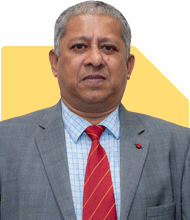Ramalingam Kalirajan |10017 Answers |Ask -Follow
Mutual Funds, Financial Planning Expert - Answered on May 06, 2024
He has an MBA in finance from the University of Madras and is a certified financial planner.
He is the director and chief financial planner at Holistic Investment, a Chennai-based firm that offers financial planning and wealth management advice.... more

I am 43 years old and a salaried person. Started in SIP in 2018. Kindly suggest about the funds. Following are my current mutual fund investments: 1) Franklin India Prima fund Rs.1000 2) Invesco India Contra Fund Rs.6000 3) Kotak flexicap fund Rs.4000 4) Mirae Large & midcap fund Rs.2000 5) Axis Bluchip fund 3500 6) Sbi Banking & financial service fund Rs.3500 7) Axis Small cap fund Rs.5000. All i have monthly SIP. please suggest me if any changes require.
• Diversification: You have a good mix of funds across various categories, which is essential for diversification. It's important to spread your investments across different sectors and market capitalizations to reduce risk.
• Review Performance: Periodically review the performance of your funds to ensure they are meeting your expectations and performing in line with their peers and benchmarks.
• Consider Your Goals: Reflect on your financial goals, risk tolerance, and investment horizon to determine if your current funds align with your objectives. If you have specific goals such as retirement planning or wealth accumulation, consider adjusting your portfolio accordingly.
• Evaluate Fund Managers: Assess the track record and expertise of the fund managers managing your investments. Look for consistency in performance and a clear investment strategy aligned with your goals.
• Stay Informed: Keep yourself updated with market trends, economic developments, and changes in regulations that may impact your investments. Stay connected with your financial advisor or conduct your research to make informed decisions.
• Seek Professional Advice: Consider consulting with a Certified Financial Planner (CFP) or a qualified financial advisor to get personalized advice based on your financial situation and goals. They can provide valuable insights and recommendations tailored to your needs.
Overall, while your current mutual fund portfolio appears well-diversified, it's essential to periodically review and adjust your investments based on changes in your financial situation and market conditions. By staying disciplined and informed, you can work towards achieving your financial goals effectively.
You may like to see similar questions and answers below
Omkeshwar Singh | Answer |Ask -Follow
Head, Rank MF - Answered on Jul 07, 2022
Hemant Bokil | Answer |Ask -Follow
Financial Planner - Answered on Apr 27, 2023
Ramalingam Kalirajan |10017 Answers |Ask -Follow
Mutual Funds, Financial Planning Expert - Answered on Apr 22, 2024
Ramalingam Kalirajan |10017 Answers |Ask -Follow
Mutual Funds, Financial Planning Expert - Answered on May 15, 2024
Prof Suvasish Mukhopadhyay |2742 Answers |Ask -Follow
Career Counsellor - Answered on Jul 31, 2025
Prof Suvasish Mukhopadhyay |2742 Answers |Ask -Follow
Career Counsellor - Answered on Jul 31, 2025
Dr Nagarajan J S K |2116 Answers |Ask -Follow
NEET, Medical, Pharmacy Careers - Answered on Jul 31, 2025
Dr Nagarajan J S K |2116 Answers |Ask -Follow
NEET, Medical, Pharmacy Careers - Answered on Jul 31, 2025
Dr Nagarajan J S K |2116 Answers |Ask -Follow
NEET, Medical, Pharmacy Careers - Answered on Jul 31, 2025
Dr Nagarajan J S K |2116 Answers |Ask -Follow
NEET, Medical, Pharmacy Careers - Answered on Jul 31, 2025
Dr Nagarajan J S K |2116 Answers |Ask -Follow
NEET, Medical, Pharmacy Careers - Answered on Jul 31, 2025
Nayagam P P |9752 Answers |Ask -Follow
Career Counsellor - Answered on Jul 31, 2025
Nayagam P P |9752 Answers |Ask -Follow
Career Counsellor - Answered on Jul 31, 2025
Ravi Mittal |629 Answers |Ask -Follow
Dating, Relationships Expert - Answered on Jul 31, 2025






















